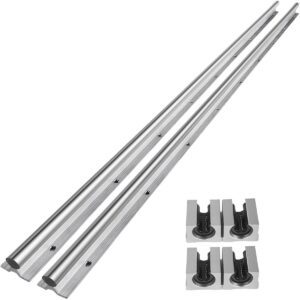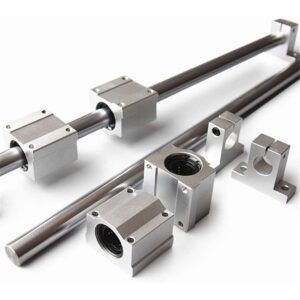Precision motion is the cornerstone of modern engineering. From CNC machines and robotics to semiconductor manufacturing and laboratory automation, the need for accurate, smooth, and repeatable linear movement is essential. At the center of this motion lies one of the most vital mechanical components: the linear motion guide rail.
This in-depth guide explores every facet of linear motion guide rails — their structure, function, classification, advantages, maintenance, and role in advancing industrial automation. Whether you’re a mechanical engineer, designer, or enthusiast, understanding this component can transform your design efficiency and motion control strategy.
Understanding Linear Motion Guide Rails
A linear motion guide rail is a mechanical system that enables precise, low-friction movement along a straight path. It consists primarily of a guide rail and a carriage (or slider) that travels smoothly along the rail using rolling elements such as ball bearings or rollers.
Unlike traditional sliding mechanisms that rely on direct contact — which causes high friction and wear — linear motion guide rails use rolling contact. This drastically reduces friction, enhances accuracy, and extends service life.
In short, linear motion guide rails transform rotary motion from motors or actuators into controlled linear displacement — forming the backbone of automation and precision engineering.
Components of Linear Motion Guide Rails
Each linear guide rail system is engineered with high precision, incorporating several key components that work together harmoniously:
Guide Rail:
The hardened track that defines the linear path. Typically made from carbon steel, stainless steel, or aluminum, it is ground and finished to high tolerances.Carriage (Slider or Block):
The moving part that supports the load and glides along the rail. Inside the carriage are recirculating ball bearings or rollers that enable smooth motion.Rolling Elements:
Balls or rollers that minimize friction between the carriage and the rail. These elements circulate through a defined path, ensuring continuous motion without slipping.End Caps and Seals:
These prevent dirt, dust, and contaminants from entering the rail assembly while keeping lubrication inside.Lubrication System:
Some designs feature built-in lubrication ports or reservoirs to maintain consistent lubrication, reducing maintenance frequency.
Each component is meticulously designed to handle high loads, provide stability, and ensure repeatable motion over long operational cycles.
Working Principle of Linear Motion Guide Rails
The operation of a linear motion guide rail is based on rolling contact mechanics. When an external force — typically from a motor or actuator — moves the carriage, the rolling elements inside the carriage roll along the raceways of the guide rail.
As the carriage travels, the balls or rollers recirculate inside a closed loop within the block, maintaining continuous contact with the rail surface. This results in smooth, low-resistance motion that minimizes energy loss and wear.
This principle allows linear guide rails to maintain micrometer-level precision even under dynamic and high-load conditions.
Types of Linear Motion Guide Rails
Different applications demand different rail designs. Here are the main types of linear motion guide rails used today:
Profiled Ball-Type Linear Guide Rails
This is the most common type used in high-precision machinery. It features a rail with defined raceways that match the ball paths in the carriage. The recirculating ball system provides excellent rigidity, high accuracy, and low friction.
Crossed Roller Linear Guide Rails
Instead of balls, these rails use cylindrical rollers arranged in alternating directions. This setup delivers superior stiffness, minimal deflection, and high load-bearing capability — perfect for optical and measurement systems.
Round Shaft Linear Guide Rails
A simpler design where a carriage moves along a cylindrical shaft using bushings or linear bearings. Though less precise than profiled rails, it’s ideal for light-duty applications and prototyping.
Dovetail and Boxway Guide Rails
These sliding-contact rails are typically found in heavy-duty machine tools. They can handle substantial loads and dampen vibration, though they require lubrication and generate more friction than rolling systems.
Miniature Linear Guide Rails
Designed for compact devices such as 3D printers, scanners, and precision laboratory instruments. They maintain the same principle of rolling motion but on a smaller scale.
Advantages of Linear Motion Guide Rails
Choosing linear motion guide rails brings a multitude of performance and design advantages:
Unmatched Precision:
Achieves micro-level accuracy essential for machining, robotics, and optical equipment.Low Friction and Smooth Motion:
Rolling contact reduces friction by up to 90% compared to sliding systems.High Load Capacity:
Evenly distributes loads across multiple rolling elements, handling heavy weights effortlessly.Rigidity and Stability:
The design resists deformation, ensuring consistent positioning under various forces.Durability:
Hardened rails, effective seals, and lubrication systems extend operational lifespan.Energy Efficiency:
Reduced friction leads to lower energy consumption and minimal heat generation.
Limitations of Linear Motion Guide Rails
Despite their benefits, linear motion guide rails also present certain limitations:
Cost:
Precision-ground components and high-grade materials make these systems more expensive.Alignment Sensitivity:
Even minor misalignment during installation can cause premature wear or vibration.Environmental Vulnerability:
Dust or debris infiltration can impair smooth motion without proper sealing.Lubrication Needs:
Although some models are self-lubricating, most require periodic maintenance to perform optimally.
Applications of Linear Motion Guide Rails
Linear motion guide rails are integral to a wide range of industrial and technological systems. Below are their most prominent applications:
CNC Machines and Milling Equipment:
Provide precise movement of machine tools and work tables.Robotics and Automation Systems:
Enable repeatable and reliable movement for robotic arms and actuators.3D Printers and Laser Cutters:
Ensure smooth, precise head movement and consistent material handling.Medical and Laboratory Equipment:
Support controlled linear motion in imaging systems, diagnostic machines, and sample handling devices.Semiconductor Manufacturing:
Used in wafer inspection, etching, and photolithography systems that demand sub-micron accuracy.Packaging and Assembly Lines:
Facilitate fast, accurate linear motion for labeling, sorting, and sealing machines.Automotive and Aerospace Manufacturing:
Used in automation cells for welding, inspection, and part assembly.
Factors to Consider When Selecting Linear Motion Guide Rails
Selecting the appropriate rail involves balancing precision, durability, and cost considerations. Key selection factors include:
Load Capacity:
The combined weight of the moving part and any additional forces acting on it.Travel Distance (Stroke):
The required motion length the rail must support.Speed and Acceleration:
High-speed applications demand low-friction, high-rigidity rails.Operating Environment:
Consider factors such as dust, humidity, and exposure to chemicals.Material Composition:
Stainless steel offers corrosion resistance, while aluminum provides lightweight efficiency.Mounting Surface Quality:
Flat, rigid surfaces ensure proper alignment and prevent uneven wear.Maintenance Frequency:
Some systems require minimal upkeep, while others demand periodic re-lubrication.
Maintenance and Care for Linear Motion Guide Rails
Proper maintenance ensures long-term reliability and precision. Here’s how to care for your guide rails:
Regular Cleaning:
Remove dust, chips, and debris from the rail and carriage.Lubrication:
Use manufacturer-recommended grease or oil at specified intervals.Inspection:
Check seals, bearings, and fasteners periodically for wear or looseness.Alignment Checks:
Recalibrate periodically to maintain straightness and avoid binding.Environmental Protection:
Use covers or bellows in dusty or corrosive settings.
Consistent maintenance can extend rail lifespan by years and prevent costly downtimes.
Emerging Trends in Linear Motion Guide Rail Technology
Modern advancements continue to refine the performance and functionality of guide rail systems. Notable innovations include:
Self-Lubricating Rails:
Materials and coatings that automatically manage lubrication needs.Smart Rails:
Integrated sensors to monitor temperature, vibration, and lubrication status.Lightweight Composites:
Use of carbon fiber and advanced alloys to reduce mass without compromising strength.Noise Reduction Technologies:
Improved designs that minimize vibration and sound during operation.
These trends reflect the growing demand for precision, automation, and sustainability in industrial applications.
Linear Motion Guide Rails
At their core, linear motion guide rails are more than just mechanical supports — they are precision enablers. By combining stability, low friction, and adaptability, they make the impossible achievable in modern manufacturing. From tiny laboratory instruments to massive CNC machining centers, these rails define the accuracy, reliability, and smoothness of every movement.
Frequently Asked Questions
What is the main purpose of linear motion guide rails?
They guide and support components in a straight line with high accuracy and minimal friction.
How do linear motion guide rails differ from linear bearings?
Guide rails define the path, while bearings provide the smooth motion along that path.
What materials are linear motion rails made of?
Most rails are made from hardened steel, stainless steel, or aluminum for corrosion resistance.
Can they operate in harsh environments?
Yes, with proper sealing, coating, or stainless-steel construction, they can perform in harsh or cleanroom conditions.
What is the lifespan of a linear motion guide rail?
With proper maintenance and lubrication, a rail can last for millions of cycles without degradation.
Are linear motion guide rails suitable for vertical applications?
Yes, as long as they are properly supported and designed for the expected load direction.
Conclusion
The linear motion guide rail represents one of the most fundamental yet transformative innovations in mechanical design. It ensures that precision equipment moves flawlessly, consistently, and efficiently. By understanding its principles, types, and maintenance requirements, engineers can harness its potential to create machines that redefine accuracy and durability.
From industrial automation to scientific instruments, linear motion guide rails remain an irreplaceable cornerstone of modern motion technology.

Inbound Link Suggestions:
[Understanding Linear Bearings and Motion Systems]
[How CNC Machines Achieve High Precision]
[Automation and Robotics Design Fundamentals]
Outbound Link Suggestions:
Technical design manuals for motion components
Engineering journals on motion system optimization
Research studies on low-friction rolling elements


